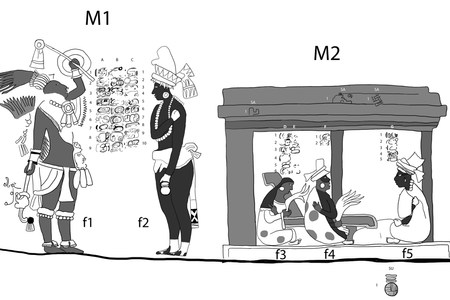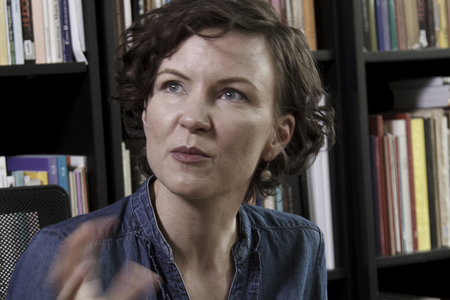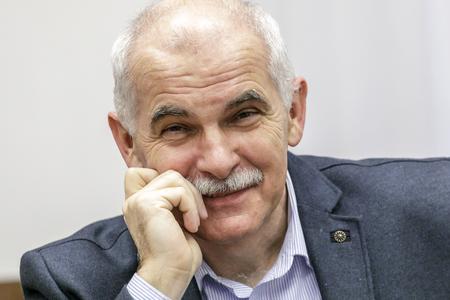You are reading this article courtesy of the ESET Science Award, an award from the ESET Foundation that supports exceptional science in Slovakia.
For a long time in Slovakia, science has been underfunded and Slovak scientists have repeatedly called on governments for greater support.
The question of what scientists would research if they had enough funds is something people do not often hear about. Therefore, the Sme daily asked some of them exactly that.
The question was as follows: “With an unlimited amount of money and resources, what would you like to research?”
Juraj Gregáň
Geneticist
I do not like to think about projects that are not real. But in this case, I can say exactly what I would do. I would build a new science institute.I do not like to think about projects that are not real. But in this case, I can say exactly what I would do. I would build a new science institute.
I would create an environment within the institute that would attract the best scientists.
The institute would work with scientists from various disciplines, including mathematics, physics, biology, chemistry and medicine, who would study topics that are important to our society.
Ján Svoreň
Astronomical Institute of the Slovak Academy of Sciences (SAV)
Although there is, unfortunately, a non-zero chance that humanity will destroy itself, there is also an objective threat that we face. It is the threat to civilisation from a collision with a large asteroid or comet.
The Earth orbits in an environment of interplanetary bodies and our observations - the cratering of non-atmospheric body surfaces, comet collision with Jupiter and increasingly frequent discoveries of asteroids flying in close proximity to Earth - confirm that it is not a question of whether a collision will occur, but when it will happen.
Today, astronomy is aware of more than 93 percent of bodies, one to two kilometres in size, that could threaten the Earth. These bodies are monitored and their slightly variable paths are constantly refined. The problem, however, is that astronomers can only observe dangerous objects in the night sky. A body arriving from the direction of the Sun is invisible to optical systems until the last moment.
If we had unlimited resources, the problem could be solved by several large space telescopes placed in orbit around the Sun at the distance of Venus, which could capture these objects in time.
And, of course, huge resources are also needed to develop technologies that could destroy a dangerous body discovered in this way. Bruce Willis with his space jackhammer is not the answer.
Milan Kováč
Mayologist, Faculty of Arts, Comenius University in Bratislava
First, I must say that for many of us, existing funding schemes, such as VEGA and APVV, would suffice for research.
The problem, however, is that the allocation of money is often decided by the same people who apply for it for themselves, or their institutions and colleagues. They have formed alliances and have strange mechanisms for distributing finance. In this way, high-quality projects find it difficult to get support, and the whole of Slovak science is distorted by alliances of the average and, unfortunately, the below-average.
However, if I were to dream my own dream of unlimited finance, and I emphasise again that I would achieve most of what I need with limited but fairly allocated resources, then I would bet on new technologies in archaeology. I would buy a state-of-the-art LiDAR – a laser scanner for aerial photography of the Earth's surface - and I would finish scanning large areas of the Guatemalan jungle, which is the project I am working on now.
I would entrust the detection of Mayan cities, pyramids, roads, and fields to the developed system of artificial intelligence, which we are also working on with my colleagues from Košice. Then we could create maps of the entire lost Mayan civilisation.
I would then send well-equipped, extensive archaeological and technological teams with ground-penetrating radars, 3D scanners, and so forth to key locations. I think that we would be able to solve many big problems in a short time, including the mysterious demise of the Mayan civilisation, and perhaps what that means for our own.
Veronika Verešová
SAV’s Institute of Oriental Studies/Aigyptos Foundation
It would certainly be research into ancient Egypt.
My colleagues and I are doing this through archaeological research and analysis of the material found in the Tell el-Retaba site in the eastern Nile Delta. Despite the fact that research has been going on here for several years, we have managed to examine only a very small part so far. It has incredible potential, and our discoveries are literally rewriting history.
On the one hand, it is clear that there were military forts associated with the temple of the rulers Ramesses II and III, and thus literally treasures that would tell us more about their activities not only in this part of the country. On the other hand, we would need funds mainly for the analysis of the findings, to determine their composition, origin, and age. It is the age, which can be determined for organic findings by the carbon (C14) method, that would be crucial.
This locality was also inhabited in the Second Intermediate Period and at the beginning of the New Kingdom, that is, in periods the length of which is still uncertain. With such an analysis, we could confirm or refute the results so far, which would have a major impact on the knowledge of this culture for the whole world.
And why ancient Egypt? Because its history, culture and society in many ways have something to teach us about the present, not to mention that the study and presentation of Egypt have the potential to arouse interest in history and cultural values. And this is something that motivates humanity to fight for survival even in times of crisis, so that it can continue to create and preserve these values.
Martin Bačkor
Department of Botany, Faculty of Science, Pavol Jozef Šafárik University in Košice
As an ecologist and plant physiologist, I know that unlimited resources do not exist in nature. Just like in human society. The COVID-19 pandemic is an unpleasant test for our society, but its scope and impact will be less significant to us than the impact of global change that our children or grandchildren will witness.
I do not trivialise the pandemic at all. I am fully aware of the impact of this pandemic on human society.
Today, the issue of global change has been pushed to the margins, but the solution to the phenomenon of global change on our planet will be significantly advanced later. At the same time, it can be said that ecology is the economy of nature and perhaps "vice versa" the economy can be considered the ecology of money.
Slovakia does not have unlimited resources to support research and science. Budgets for science and research in our country have been disproportionately lower than, for instance, in the Czech Republic for a long time.
If I had the opportunity to allocate ‘unlimited resources’, I would support almost every type of research not only in the natural and technical sciences, including applied research in medicine, pharmacy, agriculture, forestry, but also in the humanities.
Personally, I would intensively study the stress physiology of plants with regard to climate change or the issue of declining biodiversity of organisms, or the issue of environmental pollution, for example, by heavy metals and plastics, and the resistance of microorganisms to antibiotics. Or I would test biologically active substances from plants for pharmaceutical use.
Samuel Kováčik
Theoretical physicist, Vedátor_sk
It is a difficult question. There are two areas where money is very important, and I can imagine that I could work within those.
The first is the field of renewability, which transcends an enormous number of scientific disciplines and deals with the very acute problems of humanity. The second is space research. There is a lot that stands and falls precisely on the lack of funding.
My current area of research is the quantum structure of space and gravity. In this area people are already thinking about sophisticated experiments that could reveal the quantum nature of gravity. This would appeal to me very much.
Ján Baláž
Space designer, SAV, member-correspondent of the International Astronautical Academy
I cannot imagine any personal commitment to unlimited funding, but I would like to draw attention to an area that deserves it. The universe is undoubtedly beautiful, but nothing we have observed in it so far can be compared to the splendour and hospitality of our planet. Maintaining its habitability deserves the highest priority of many scientific disciplines, including astronomy and astronautics, where protection against the collision of the Earth with a dangerous alien body dominates.
Research into the functional diversity of soil microorganisms would mark a new era in the view of soil and the sustainable development of agricultural policy in Slovakia.“
While astronomy has made great strides in detecting potentially dangerous objects, in the field of astronautics, considerable helplessness remains with regard to transporting a heavier load to such an object quickly enough to divert it from a collision trajectory.
This is especially true for non-periodic comets, which quite often penetrate deep into the inner solar system where the only thing that protects us from them is ‘Lady Luck’. They have a small probability of collision, as the Earth is still a tiny object in the solar system.
That is why I think it is necessary to invest in the development of much more energetic propulsion systems. The current chemical drives are insufficient and flights with the gravitational assistance of the planets are too long. Unless there are fundamental discoveries in physics that can be used for this purpose in the foreseeable future, we are probably left with only nuclear energy, which is several orders of magnitude more energetic than chemical energy. Research and technology in this area are extremely demanding and expensive, but we do not know of any other way yet.
Peter Tóth
Archaeologist, Masaryk University in Brno
At present, I deal with the issue of the transition from a hunting and gathering way of life to the first farmers in central Europe, referred to as neolithization, which occurred around the middle of the 6th millennium BC. This research question is very attractive, as neolithization meant a huge change in the way of life.
Man not only settled, he also lived in houses with a solid structure and devoted himself to agriculture and breeding domestic animals. These changes went hand in hand with changes in dietary composition, ideology, and with the discovery of new technologies.
Current research explains neolithization in three ways: migration, acculturalization [the original population adopts a new way of life] and integration [a combination of both models]. New analyses of aDNA [ancient DNA] show that we must take into account the migrations of the population of Balkan-Anatolian origin who were the bearers of the new way of life.
However, the question is how extensive this migration was, how it took place and how long it lasted. In the case of unlimited financial resources, it would be possible to carry out research of world importance. Based on the whole genome aDNA analyses in combination with stable isotope analyses - their amount does not change over time and indicates dietary composition or paleo-migrations and radiocarbon dating, several of the above questions could be answered.
In addition, we would get a plastic picture of the structure of prehistoric society and kinship. Finally, we could consider the causes [climatic, social] that led to this migration.
Slavomír Adamčík
SAV’s Centre for Plant Biology and Biodiversity
In the laboratory of molecular ecology and metagenomics of the Centre for Plant Biology and Biodiversity of the Slovak Academy of Sciences, we study the functional diversity of microorganisms in the soil.
For many of us, existing funding schemes, such as VEGA and APVV, would suffice for research. The problem, however, is that money is often decided by the same people who apply for it themselves, or their institutions and colleagues. They have formed alliances and have strange mechanisms for distributing finance.“
Soil is considered a national heritage by the Slovak public. People want healthy food, food self-sufficiency, and challenges such as the decline of biological diversity, the ability of the soil to maintain favourable mineral conditions and retain water are closely related to people’s wants.
The soil is a microcosm. In one sample it is possible to identify hundreds of species of fungi, bacteria, and animals. Advanced DNA sequencing methods are used for identification. Further analyses of mediator RNA, complex enzymatic activities and metabolic products will show whether microbial communities have a positive effect on plants and soil development. Various management interventions in agricultural land cause irreversible soil degradation and changes in the microbial community.
Microorganism research can distinguish and identify soil quality. Trophic [food and symbiotic] profiling of individual types of soil microorganisms can increase our understanding of their function. Soil microorganisms not only allow nutrients to circulate in the soil, but their enzymatic activities allow access to mineral elements that are not directly accessible to plants.
Research into the functional diversity of soil microorganisms would mark a new era in the view of soil and the sustainable development of agricultural policy in Slovakia. It would require the cooperation of leading Slovak microbiologists, ecologists, pedologists and geographers, and higher financial resources would be of help in this regard.
Iveta Vasková
Dean of the Faculty of Materials, Metallurgy and Recycling of the Technical University of Košice
Slovakia spends very little on research and innovation, only around 0.9 percent of GDP, which is the least of the Visegrad Region countries. For comparison, in the Czech Republic it is about 1.8 percent. The EU average is around 2 percent. The highest expenditure on science and research is in Sweden, it is around 3.3 percent. Cyprus, Malta, Latvia, and Romania have the lowest, around 0.5 percent.
Back to the question from the perspective of the Faculty of Materials, Metallurgy and Recycling:
Materials: the combination of hydrogen technologies and water management - capture, remediation and treatment of rainwater quality using nanomaterials with a functional surface and hydrogen production using newly developed electrolysers, using advanced materials for electrodes, storage and distribution of hydrogen as an energy carrier.
Battery systems: composite electrodes in intelligent batteries with continuous diagnostics of their quality and condition with extended life and at the same time prediction of life.
Smart coatings: smart coatings with a self-repairing effect after mechanical damage for the automotive, energy and transport industries.
Artificial intelligence and materials: use of artificial neural networks in predicting the properties of materials based on quantum-chemical calculations.
Metallurgy: construction of an independent research centre focusing on physical and mathematical simulations of processes [thermodynamic, high-temperature, heat and mass exchange, flow, combustion]. We already have a personnel base for the creation of such a centre.
Recycling: elementary and applied research in the field of recycling of secondary raw materials.
©Sme






